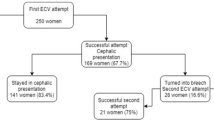Abstract
Purpose
The risk of cesarean delivery after a successful external cephalic version for breech presentation is higher as compared with fetuses in cephalic presentation. However, the role of the time interval between version attempt to delivery on the risk for cesarean delivery is unclear. We aimed to study the effect of the time interval from a successful external cephalic version to delivery on the risk for cesarean delivery and assess factors associated with cesarean delivery after a successful version.
Methods
We conducted a multicenter, retrospective cohort study, including all successful external cephalic version at two medical centers between 2011 and 2019. We compared patient baseline characteristics, obstetric characteristics, maternal and neonatal outcomes in women that delivered by vaginal delivery with those who delivered by cesarean delivery.
Results
Overall, 769 deliveries were included. Of these, 98 women (12.7%) had cesarean delivery and 671 (87.3%) had vaginal delivery. Women who had cesarean delivery had a higher rate of obesity (44.9% vs 21.9%, p < 0.001; OR 2.88, CI 1.65–5.03) and nulliparity (45.9% vs 24.5%, p < 0.001; OR = 2.58, CI 1.67–3.98). The risk for intrapartum cesarean delivery did not differ according to time interval from external cephalic version to delivery.
Conclusions
The time interval between successful external cephalic version and delivery was not associated with mode of delivery. This finding is in contrast to previous reports. The risk for cesarean delivery after successful version is higher in nulliparous, obese women, and women whose weight gain in pregnancy was higher.

Similar content being viewed by others

References
Hofmeyr GJ, Kulier R, West HM (2015) External cephalic version for breech presentation at term. Cochrane Database Syst Rev 4:CD000083. https://doi.org/10.1002/14651858.CD000083.pub3
Hannah ME, Hannah WJ, Hewson SA, Hodnett ED, Saigal S, Willan AR (2000) Planned caesarean section versus planned vaginal birth for breech presentation at term: a randomised multicentre trial. Term Breech Trial Collaborative Group. Lancet 356:1375–1383
Hogle KL, Kilburn L, Hewson S, Gafni A, Wall R, Hannah ME (2003) Impact of the international term breech trial on clinical practice and concerns: a survey of centre collaborators. J Obstet Gynaecol Can 25(1):14–16
Barber EL et al (2011) Indications contributing to the increasing cesarean delivery rate. Obstet Gynecol 118:29–38
Zhang J, Troendle J, Reddy UM, for the Consortium on Safe Labor et al (2010) Contemporary cesarean delivery practice in the United States. Am J Obstet Gynecol 203:326.e1–10
Hundt M, Velzel J, de Groot CJ, Mol BW, Kok M (2014) Mode of delivery after successful external cephalic version: a systematic review and meta-analysis. Obstet Gynecol 123(6):1327–1334
Weiniger CF, Lyell DJ, Tsen LC et al (2016) Maternal outcomes of term breech presentation delivery: impact of successful external cephalic version in a nationwide sample of delivery admissions in the United States. BMC Pregnancy Childbirth 16(1):150
Chan L, Leung T, Fok W, Chan L, Lau T (2004) Prediction of successful vaginal delivery in women undergoing external cephalic version at term for breech presentation. Eur J Obstet Gynecol Reprod Biol 116:39–42
Kew N, DuPlessis J, Paglia DL, Williams K (2017) Predictors of cephalic vaginal delivery following external cephalic version: an eight-year single-centre study of 447 cases. Obstet Gynecol 2017:3028398
Ben-Haroush A, Perri T, Bar J, Yogev Y, Bar-Hava I, Hod M, Kaplan B (2002) Mode of delivery following successful external cephalic version. Am J Perinatol 19(7):355–360
Kuppens SM, Hutton EK, Hasaart TH, Aichi N, Wijnen HA, Pop VJ (2013) Mode of delivery following successful external cephalic version: comparison with spontaneous cephalic presentations at delivery. J Obstet Gynaecol Can 35(10):883–888
Barabash-Hazan S, Nattiv N, Salzer-Sheelo L, Bergel R, Hadar E, Osovsky M, Shmueli A (2019) Induction of labor versus expectant management after successful external cephalic version. Birth 00:1–5
Hants Y, Kabiri D, Elchalel U, Arbel-Alon S, Drukker L, Ezra Y (2015) Induction of labor at term following external cephalic version in nulliparous women is associated with an increased risk of cesarean delivery. Arch Gynecol Obstet 92(2):313–319
Kabiri D, Elram T, Aboo-Dia M, Elami-Suzin M, Elchalal U, Ezra Y (2011) Timing of delivery after external cephalic version and the risk for cesarean delivery. Obstet Gynecol 118:209–213
Lim PS, Ng BK, Ali A, Shafiee MN, Kampan NC, Ismail M et al (2014) Successful external cephalic version: factors predicting vaginal birth. ScientificWorld J 2014:860107
Funding
No specific funding or support was obtained for the purpose of this study.
Author information
Authors and Affiliations
Contributions
All authors contributed to the study conception and design. Material preparation, data collection and analysis were performed by TC, GL, YW, RP and RM. The first draft of the manuscript was written by TC and all authors commented on previous versions of the manuscript. All authors read and approved the final manuscript. TC: data collection and management, project development, manuscript writing/editing. GL: data collection and management, project development, data analysis, manuscript writing/editing. OM: data collection and management, project development. YW: data collection and management. RP: data collection and management. RM: data collection and management, project development, manuscript writing/editing.
Corresponding author
Ethics declarations
Conflict of interest
The authors of this study have no conflict of interest to attest for.
Ethics approval
This study was performed in line with the principles of the Declaration of Helsinki. Approval was granted by the Ethics Committee of Bikur Cholim Medical Center and Sheba Medical Center (IORG0001519 and 5319–18-SMC).
Availability of data and material
Available upon request.
Code availability
Not applicable.
Additional information
Publisher's Note
Springer Nature remains neutral with regard to jurisdictional claims in published maps and institutional affiliations.
Rights and permissions
About this article
Cite this article
Cahan, T., Levin, G., Moran, O. et al. Successful vaginal delivery after external cephalic version (ECV): does time interval from ECV to delivery make a difference? A multicenter study. Arch Gynecol Obstet 302, 1361–1367 (2020). https://doi.org/10.1007/s00404-020-05733-w
Received:
Accepted:
Published:
Issue Date:
DOI: https://doi.org/10.1007/s00404-020-05733-w



